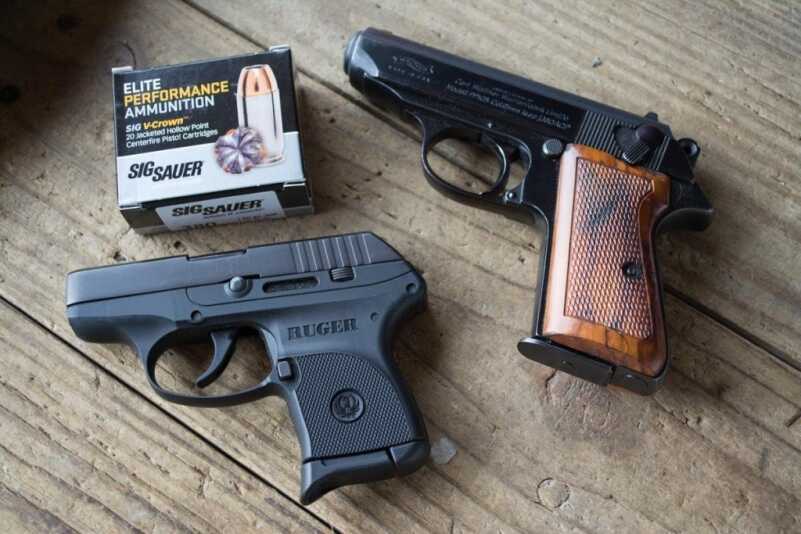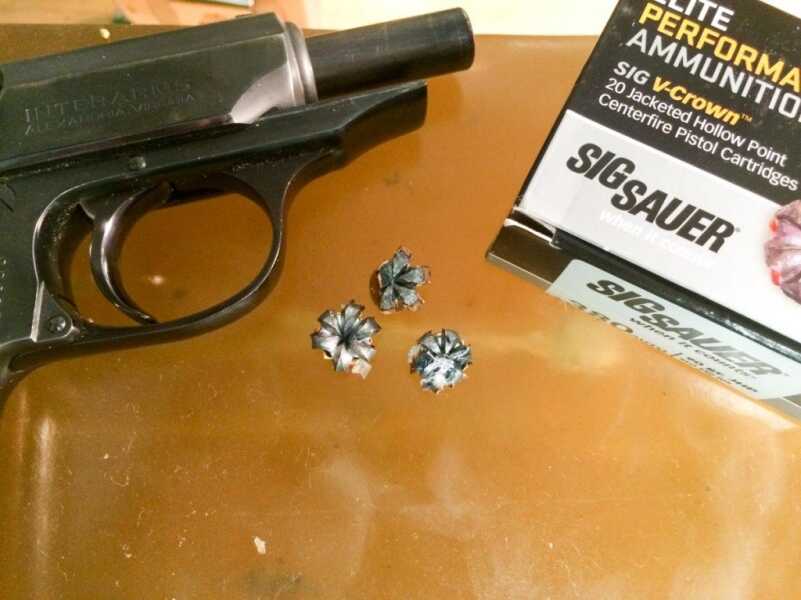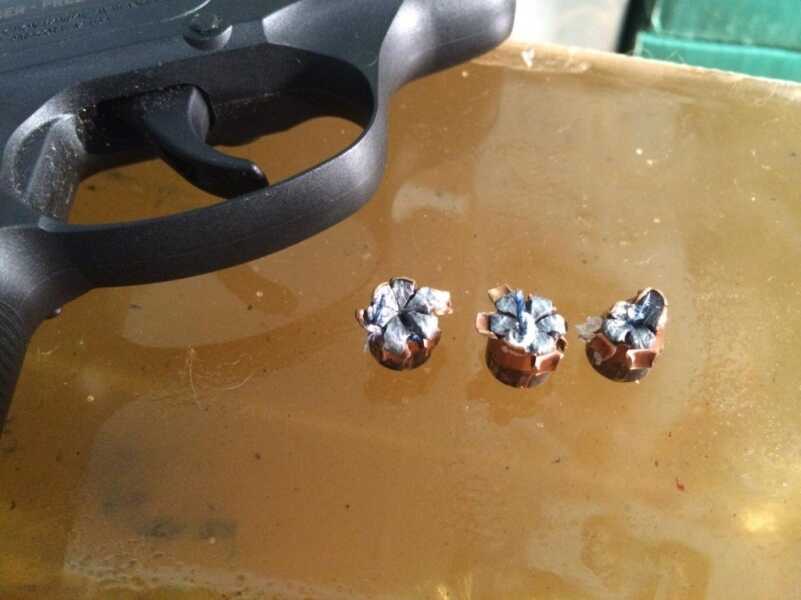
This week, we’ll test Sig Sauer’s new Elite Performance .380 ACP, 90 grain V-Crown self-defense load.
.380 ACP is a pain in the butt. It’s convenient, and you can make obscenely small and handy guns that can handle the caliber, but it’s a borderline cartridge in terms of performance. I’m guessing it gives ammo manufacturers fits. Why?
It’s a light bullet. Generally, 380 ACP rounds are about 90 grains in weight, or roughly ¾ the weight of a 9mm self-defense projectile and just 40% the weight of a .45 ACP bullet.
Velocity is limited to about 1,000 feet per second for 90-grain loads. You can only pack so much powder and pressure into that little cartridge without blowing up your micro gun.
Recoil has to be manageable in micro mini guns weighing less than a butterfly’s left leg.
Worse yet, with all those limitations, we expect a .380 ACP round to level a city block should we ever need to use it for self-defense.
I guess it just shows how we humans emphasize hope. There are guns that are tiny and easy to carry, so we hope (and assume) that they will provide enough oomph to get the job done.
With all that said, I guess it’s not surprising that most of the .380 rounds I test don’t compare to their 9mm and larger siblings. It’s simply a physics nightmare to produce a round that does what we want within the constraints of the cartridge. Sure, if you look at the ads, you’ll see lots of impressive pictures of perfectly expanded .380 ACP bullets, but did you read the fine print? I could probably get a can of spackle to expand if I fired it into water or uncovered ballistic gelatin. Most any bullet will make a picture perfect mushroom when fired into bare gel. The trick is making it perform that way after passing through clothing or other barriers.
The folks at the new Sig Sauer ammunition factory are pretty proud of their V-Crown bullets, so I’ve been testing different loads and calibers. A few weeks back, we looked at the 9mm 124 grain V-Crown bullet and it showed impressive performance. Will the 90-grain .380 ACP perform equally well? Let’s find out.
Velocity
The box says muzzle velocity is 980 feet per second, but you never really know what that means. Velocity is largely dependent on the barrel length. Is that the speed from a 2-inch barrel? 3-inch? 4-inch? To find out, I tested velocity using a Shooting Chrony Beta Master Chronograph placed 15 feet downrange. I used two different pistols to represent common barrel lengths popular in the .380 ACP world. For the micro pistol, I used a Ruger LCP .380. This tiny little gun has a 2.75-inch barrel and much of that is the chamber, so it’s comparable in useful barrel length to a snubby revolver. The other test gun was a Walther PPK/S. While not a common carry gun anymore, it’s got a 3.3-inch barrel, which is pretty common.
Shooting a bunch of shots through the chrony with both pistols, I observed the following average velocities, 15 feet down range.
Walther PPK/S: 970.8 feet per second
Ruger LCP: 881.5 feet per second
Based on these results, I’m guessing the factory listed velocity is for a 3.5-inch barrel. Also, they measure at the muzzle, with more sophisticated technology than I have at my disposal.
Penetration and Expansion
It’s time to shoot the jello. That’s what really matters, right? Again, I chose to use both pistols rather than pick one. There are a whole lot of micro .380 ACP guns being carried out there, so I wanted to see how the Sig Sauer V-Crown bullets performed from tiny guns with short barrels.
As usual for this series, I set up Clear Ballistics gelatin blocks and covered the front surface with the official FBI four-layer fabric. This is intended to simulate multiple layers of clothing including denim, cotton, and insulation.
First up was the Ruger LCP. Might as well start with the most challenging first, right? I fired three shots into a fresh gelatin block covered with my now-perforated FBI fabrics. All three projectiles penetrated to depths between 13 and 15 inches. This is good – right where you want it. When I dug the bullets out of the jello, I found that all three showed partial expansion. Two of the three projectiles expanded to .52 inches in diameter, while the third struggled a bit more, with .40-inches of expansion. All three looked like they really wanted a few more feet per second. Expansion started normally, but there just wasn’t enough energy to keep things moving. Welcome to the challenges of .380 ACP.
Next, I fired three more into a fresh gel block with the Walther PPK/S. With over a half-inch more barrel length, I figured this would provide those few extra fps. And it did. All three projectiles expanded perfectly and fully, as far as I could tell. I measured .47, .48 and .55-inches for these. The only reason they measured smaller than a couple of the LCP projectiles was that they went through a complete expansion, getting even larger, followed by the petals filing back on the body of the bullet. Penetration was 13 inches for one, 14 inches for another and 16 inches for the last. Excellent results.

Fired from the Walther PPK/S, these bullets expanded perfectly. Note the fabric clogging the bullet on the right. That didn’t seem to impact performance.
Closing Thoughts
I have to say I was pleasantly surprised. I can’t tell you how many .380 ACP bullets I’ve fired into gel through fabric barriers. Almost all of them fail to expand properly with any type of .380 ACP pistol. These performed well in the smallest of guns and the worst velocity scenario. In a slightly larger pistol, with just ½-inch more barrel length, they performed perfectly.



Hornady xtp 380 self defense ammo seems to be the best.
I just happened by this review. I am definitely going to read more gunsamerica reviews and I still love
my Bersa 383A and my Smith & Wesson 15-5.
Here is a thought about “stopping power.”
In 1981 President Reagan nearly died from a .22 rimfire which first bounced off a car door before hitting the President. The .22 round ended up just centimeters from the President’s heart. All done by an insane person with a junk hand gun.
The .380 has been around since 1908. The .380 was designed by John Moses Browning. 109 years later, the .380 is more popular than ever. Rest assured, a .380ACP will kill you stone dead. Have no doubt.
To me, all European millimeter pistols are lacking due to size restrictions stuffing rounds up a pistol handle.
Want honest to God, no excuse stopping power? Go American. Eg: .357 Magnum, .44 Magnum. .45ACP and leave the millimeter guns in the junior league.
Thanks for another excellent review that tells me, as a guy who sometimes carries a .380, what I can expect from this cartridge offering by Sig-Sauer. That is exactly what I needed to know, and I especially appreciate you testing from two common barrel lengths because that is commonly a crucial variable in understanding cartridge performance, handloading, etc. So many tests leave us guessing. Since my .380’s happen to be an LCP and a Remington 51 (3.5″ bbl.), your tests provide me with an excellent approximation of what I can expect in my guns. Mission accomplished with your report! Thanks again.
1) you get a 380 and I’ll get a 45 or 40, your choice. We’ll get 50 yds apart and start walking towards each other, firing at will, and see who drops first.
2) picked up a 380 new from a top line mfg. Four mags of ball did ok. First round of premium hollow point stove-piped. Failure is not an option in defensive gun performance or ammo.
3) 380 pistols are too short in their cycle, barrel length, and ammo dependency to function reliably. And the ammo is too small and underperforming.
4) Option: a good J-frame 38 spcl. That is reliable, twice as powerful, and about same # of rounds.
PS: just kidding about #1 :>)
I have a Kahr CT380. With ammunition it likes–stoutly loaded round-nose FMJ like Fiocchi or Prvi Partizan, or Hornady 90gr XTP hollowpoints–it runs 100%, every time. I have passed the 2000 round mark now without any non-ammo-related problems.I am not sure how a 2\” .38 Special snubby, from which chronographed velocities are typically 150-200 feet per second slower than the numbers on the box, is going to be \”twice as powerful\” as a .380. Ballistically speaking, .38 Special and .380 ACP are twins. The late Skeeter Skelton first demonstrated this 50+ years ago. .380 with 95gr FMJ at around 850 ft/sec, or .38 Special 158gr roundnose lead from a 2\” snubby at around 650 ft/sec, both produce about 150 foot-pounds of energy at the muzzle, if that. Both make identical, indistinguishable .36 caliber holes in ballistic gelatin to a depth of 18\” to 24\” depending on where and whether that long 158gr .38 bullet loses stability and begins to yaw in the gelatin (usually somewhere in the second foot of penetration), dumps its remaining energy, and comes to a stop, and this is true regardless of the presence or absence of clothing of any type. Kinetic energy does matter for penetration and disruption of hard barriers, like bone–but the kinetic energy figures are nigh identical. And going up to +P in .38 Special gets you very, very little, especially from short 2\” barrels–it\’s not that all the propellant doesn\’t burn, it\’s that the propellant gases generated don\’t have long enough to transfer energy to the base of the bullet.The only thing I can think of that\’s about \”twice as powerful\” as .380 in a firearm of similar size is 9mm. There are plenty of good singlestack 9mm concealed carry pistols available nowadays, that are all much slimmer and more concealable than any revolver. But 9mm is about twice as powerful as .38 Special, too, at least if we\’re talking about factory ammo–some 9mm ammo offers 400+ foot-pounds kinetic energy at the muzzle vs. 200, comparing service pistol with 4\” barrel to service revolver with 4\” barrel, with quicker reloads, two and a half to three times the capacity, usually a better trigger, and very little difference in recoil.In the 21st Century I don\’t know why J-frame revolvers still exist. They only hold five shots, they have a microscopic sight radius, most have tiny, nearly-unusable either plain stainless or plain black sights that disappear in poor lighting conditions, reloads can be timed with a calendar, it\’s hard to hold the front sight steady when you\’re holding a 12 ounce gun and struggling with a 12 pound DA trigger pull over an inch or so of rearward trigger travel, and the massively fat, bulky cylinder makes them thicker than a full-size 5\” 1911. In .38 Special the power offered is marginal, and going up to .357 with such a stubby barrel gives you the ballistic equivalent of 9mm at best.There was a time when a 5-shot .38 Special snubby was the best thing you could get for concealed carry. That was in 1905. Time has not stood still and advances in engineering have resulted in a wide array of choices–for everyone except people who just don\’t trust that newfangled smokeless powder, I guess.
Cool. But can we buy it? Around here even Walmart’s ammo shelves are about half stocked.
I find ammo is very easy to find online. Check gunbot.net. It’s a service that looks at dozens of online retailers to show you who has what in stock and at what price. Very handy.
Academy stocks it for $15, picked some up today.